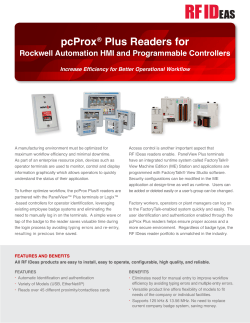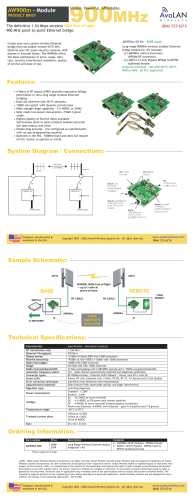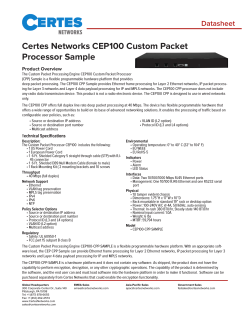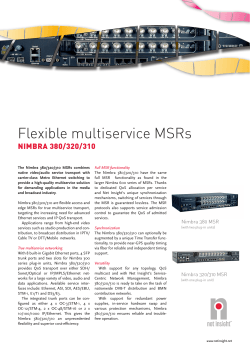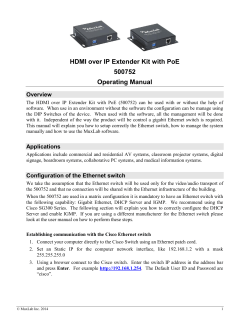
Document
Chapter 13 Wired LANs: Ethernet 13.1 Copyright © The McGraw-Hill Companies, Inc. Permission required for reproduction or display. 13-1 IEEE STANDARDS In 1985, the Computer Society of the IEEE started a project, called Project 802, to set standards to enable intercommunication among equipment from a variety of manufacturers. Project 802 is a way of specifying functions of the physical layer and the data link layer of major LAN protocols. Adopted by ANSI in 1987, ISO approved it as international standard ISO 8802. Topics discussed in this section: Data Link Layer Physical Layer 13.2 Figure 13.1 IEEE standard for LANs LLC – flow control, error control, part of framing. Provides one single data link control for all IEEE LANs MAC – Defines the specific access method for each type of LAN (Ethernet– CSMA/CD, Token Ring and Token Bus-Token Passing). Provides part of framing function. 13.3 13-2 STANDARD ETHERNET The original Ethernet was created in 1976 at Xerox’s Palo Alto Research Center (PARC). Since then, it has gone through four generations. We briefly discuss the Standard (or traditional) Ethernet in this section. Topics discussed in this section: MAC Sublayer Physical Layer 13.4 Figure 13.3 Ethernet evolution through four generations 13.5 Figure 13.4 802.3 MAC frame Preamble–alert and synchronize the receiving system to coming frame SFD-signals beginning of frame DA- physical address of the destination SA-physical address of the sender Length or Type-type: define upper layer protocol, length: the number of bytes in data field Data-data encapsulated from upper layer (min 46 and max 1500 bytes) CRC-error detection information 13.6 Figure 13.6 Example of an Ethernet address in hexadecimal notation NIC – 6 byte (48 bits) physical address 13.7 Figure 13.7 Unicast and multicast addresses Source address – only unicast Destination address – unicast, multicast, broadcast The least significant bit of the first byte defines the type of address. If the bit is 0, the address is unicast; otherwise, it is multicast. The broadcast destination address is a special case of the multicast address in which all bits are 1s. 13.8 Example 13.1 Define the type of the following destination addresses: a. 4A:30:10:21:10:1A b. 47:20:1B:2E:08:EE c. FF:FF:FF:FF:FF:FF Solution To find the type of the address, we need to look at the second hexadecimal digit from the left. If it is even, the address is unicast. If it is odd, the address is multicast. If all digits are F’s, the address is broadcast. Therefore, we have the following: a. This is a unicast address because A in binary is 1010. b. This is a multicast address because 7 in binary is 0111. c. This is a broadcast address because all digits are F’s. 13.9 Figure 13.8 Categories of Standard Ethernet (PHYSICAL LAYER) 13.10 Figure 13.9 Encoding in a Standard Ethernet implementation Use digital signaling (baseband) at 10Mbps 13.11 Figure 13.10 10Base5 implementation Known as Thicknet Thick coaxial cable Uses bus topology with external transceiver Max length of each segment 500m 13.12 Figure 13.11 10Base2 implementation Knows as Thin Ethernet Uses bus topology with thin and flexible cable Transceiver – part of NIC Max length of each segment 185m 13.13 Figure 13.12 10Base-T implementation Knows as twisted pair Ethernet Uses physical star topology Stations connected to hub Max length 100m 13.14 Figure 13.13 10Base-F implementation Uses star topology Stations connected to hub 13.15 Table 13.1 Summary of Standard Ethernet implementations 13.16 13-3 CHANGES IN THE STANDARD The 10-Mbps Standard Ethernet has gone through several changes before moving to the higher data rates. These changes actually opened the road to the evolution of the Ethernet to become compatible with other high-data-rate LANs. Topics discussed in this section: Bridged Ethernet Switched Ethernet Full-Duplex Ethernet 13.17 Figure 13.14 Sharing bandwidth Each station average 5 Mbps-bandwidth shared between stations 13.18 Figure 13.15 A network with and without a bridge Bridged Ethernet – divides the network; gain more bandwidth for each segment 13.19 Figure 13.16 Collision domains in an unbridged network and a bridged network Bridged Ethernet – separation of collision domain – probability of collision reduced 13.20 Figure 13.17 Switched Ethernet Layer 2 switch is N port bridge that allows faster handling of packets 13.21 Figure 13.18 Full-duplex switched Ethernet From switched to full duplex Ethernet, capacity is increased. No need to CSMA/CD anymore 13.22 13-4 FAST ETHERNET Fast Ethernet was designed to compete with LAN protocols such as FDDI or Fiber Channel. IEEE created Fast Ethernet under the name 802.3u. Fast Ethernet is backward-compatible with Standard Ethernet, but it can transmit data 10 times faster at a rate of 100 Mbps. Topics discussed in this section: MAC Sublayer – Only star topology, half (use hub, CSMA/CD) and full duplex (use switch, no need for CSMA/CD) mode Autonegotiation – devices negotiates the mode or data rate of operation Physical Layer 13.23 Figure 13.19 Fast Ethernet topology 13.24 Figure 13.20 Fast Ethernet implementations 13.25 Figure 13.21 Encoding for Fast Ethernet implementation 13.26 Table 13.2 Summary of Fast Ethernet implementations 13.27 13-5 GIGABIT ETHERNET The need for an even higher data rate resulted in the design of the Gigabit Ethernet protocol (1000 Mbps). The IEEE committee calls the standard 802.3z. Topics discussed in this section: MAC Sublayer Physical Layer Ten-Gigabit Ethernet 13.28 MAC Sublayer –full and half duplex approach for medium access In the full-duplex mode of Gigabit Ethernet, there is no collision; the maximum length of the cable is determined by the signal attenuation in the cable. Half duplex – rare (not discussed) 13.29 Figure 13.22 Topologies of Gigabit Ethernet 13.30 Figure 13.23 Gigabit Ethernet implementations 13.31 Figure 13.24 Encoding in Gigabit Ethernet implementations 13.32 Table 13.3 Summary of Gigabit Ethernet implementations 13.33 IEEE standard 802.3ae MAC sublayer – full duplex, no CSMA/CD Table 13.4 Summary of Ten-Gigabit Ethernet implementations 13.34
© Copyright 2025

